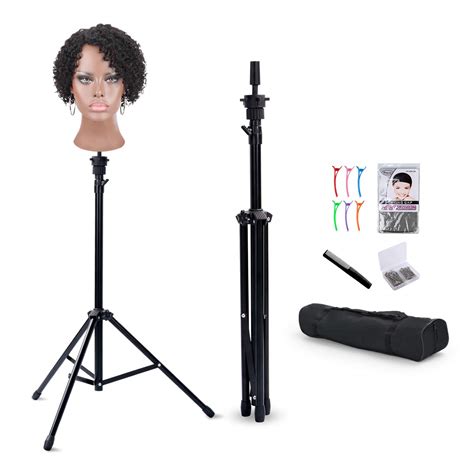Introduction
Wigs have become increasingly popular in recent years, offering versatility and convenience for both personal and professional use. However, maintaining and styling wigs requires specialized tools, and among the most essential are wig heads and wig stands. These tools provide a stable and convenient surface for storing, drying, and styling wigs, ensuring their longevity and aesthetic appeal.

Wig Heads: Types and Uses
Wig heads come in various materials and sizes to accommodate different wig types and purposes.
1. Canvas Wig Heads
Canvas wig heads are the most common type, providing a durable and lightweight base. They are ideal for everyday wig styling and storage, as they can withstand heat and chemicals used in wig care.
2. Styrofoam Wig Heads
Styrofoam wig heads are lightweight and economical, making them suitable for temporary storage or travel. However, they are not heat-resistant and should not be used for heat styling.
3. Mannequin Wig Heads
Mannequin wig heads feature faces and necks, providing a more realistic representation of the human head. They are often used by professional wig stylists and wig makers to create intricate styles.
Wig Stands: Functions and Benefits
Wig stands complement wig heads by providing a secure and stable base for wig storage and display.
1. Height-Adjustable Wig Stands
Height-adjustable wig stands allow users to adjust the height according to their needs. This is particularly convenient for wig drying, as wigs can be hung upside down to promote airflow.
2. Tripod Wig Stands
Tripod wig stands are sturdy and portable, making them ideal for travel or on-the-go wig adjustments.
3. Clamp-On Wig Stands
Clamp-on wig stands attach to tables or desks, providing a convenient and space-saving option.
Advantages of Using Wig Heads and Stands:
- Prolong wig lifespan by preventing tangles and damage
- Facilitate wig drying and styling
- Provide a stable surface for hairdressing and makeup application
- Showcase wigs for storage or display
Innovative Applications for Wig Heads and Stands
Beyond their traditional uses, wig heads and stands offer creative opportunities for:
- Wig Customization: Design and create new wig styles using wig heads as a canvas.
- Wig Repair: Repair damaged wigs by pinning them to wig heads for easy access.
- Cosplay and Theatrical Props: Use wig heads and stands to create realistic costumes and props.
Tips and Tricks:
- Choosing the Right Wig Head: Select a wig head that matches the size and density of your wig.
- Wig Placement: Position the wig on the wig head with the lace or cap facing down.
- Wig Drying: Allow wigs to dry completely on a wig stand before storing them.
- Wig Storage: Store wigs on wig heads or stands in a cool, dry place.
- Cleaning: Clean wig heads and stands regularly to prevent product buildup and maintain hygiene.
FAQs:
-
What is the difference between a wig head and a wig stand?
– Wig heads provide a surface for styling and storage, while wig stands primarily offer support for storage and display. -
What is the best type of wig head for beginners?
– Canvas wig heads are a good starting point for beginners due to their durability and ease of use. -
How long should I leave my wig on a wig head?
– Leave your wig on a wig head for as long as necessary for styling or storage. However, avoid leaving it on permanently, as this can cause the wig to stretch. -
How often should I clean my wig head?
– Clean your wig head after each use with a mild detergent to remove product residue. -
Can I use a wig head for wig dyeing?
– Yes, you can use a wig head for wig dyeing, but it is important to protect the wig head from chemicals by covering it with plastic wrap. -
What are some innovative uses for wig heads and stands?
– Wig heads and stands can be used for wig customization, wig repair, cosplay, and theatrical props.
